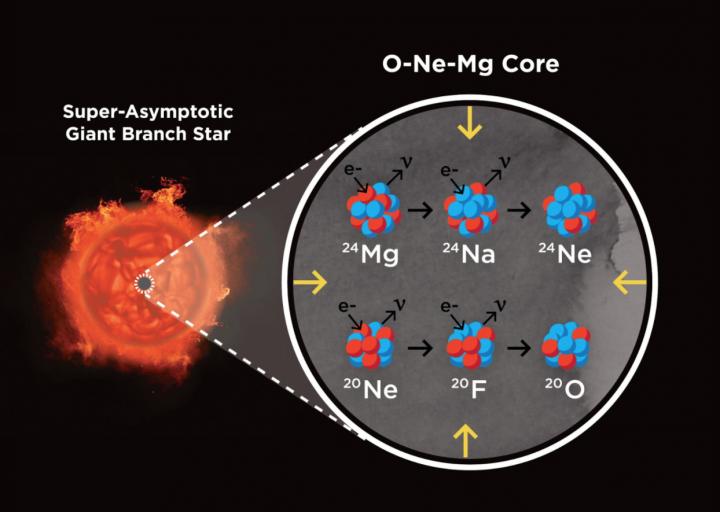Atomic nucleus swallows electrons: New supernova type found
At the end of its life, stars, if they are only heavy enough, perish in a gigantic firework, a supernova. Up to now, one knew roughly two ways to get there. A core-collapse supernova occurs when a massive star – one with more than 10 times the mass of the Sun – runs out of nuclear fuel and its iron core collapses, creating a black hole or neutron star. On the other hand, if a white dwarf – a low-mass star at the end of its lifetime – captures so much mass from a companion that it becomes unstable, a thermonuclear supernova occurs.
A worldwide team led by UC Santa Barbara scientists at Las Cumbres Observatory has now discovered the first convincing evidence of another type of stellar explosion – an electron capture supernova. In fact, the principle of this explosion was described theoretically 40 years ago. However, astronomers did not have real examples to show until now. They are thought to originate from explosions of massive stars from the Asymptotic Giant Branch of the Russel-Hertzsprung diagram (so-called SAGB stars), for which there are also few examples.
In electron-capture supernovae, stars stop nuclear fusion when their nuclei are made of oxygen, neon, and magnesium because they are not heavy enough to fuse iron. What keeps most stars from collapsing under their own gravity is either ongoing fusion or, in cores where fusion has stopped, the fact that the atoms simply cannot be packed any tighter. Now, however, when some of the electrons in the oxygen-neon-magnesium nucleus smash into their atomic nuclei in a process called electron capture, this withdrawal of electrons causes the star’s core to collapse under its own weight – the end result is a stellar explosion. Had the star been slightly heavier, the core elements could have fused to form heavier elements, which would have extended its life to a normal core-collapse supernova. The star is not light enough to escape the collapse of its core, nor is it heavy enough to prolong its life and die later by other means.
This is the theory formulated starting in 1980 by Ken’ichi Nomoto of Tokyo University and others. Over the decades, theorists have formulated predictions of what to look for in an electron capture supernova and its SAGB stellar progenitors. The stars should have a lot of mass, lose much of it before they explode, and that mass near the dying star should be of an unusual chemical composition. Then the electron-capture supernova should be faint, have little radioactive fallout and have neutron-rich elements in its core.
The new study is led by Daichi Hiramatsu, a graduate student at UC Santa Barbara and Las Cumbres Observatory (LCO). Hiramatsu is a core member of the Global Supernova Project, a worldwide team of scientists using dozens of telescopes around and across the globe. The team found that supernova SN 2018zd has many unusual features, some of which were seen for the first time in a supernova. It helped that the supernova was relatively close – only 31 million light-years away – in the galaxy NGC 2146, which allowed the team to examine archival images taken by the Hubble Space Telescope before the explosion and discover the likely progenitor star before it exploded. The observations were consistent with another recently identified SAGB star in the Milky Way, but not with models of red supergiants, the progenitors of normal iron-core collapse supernovae.
The authors looked through all the published data on supernovae and found that while some had some of the indicators predicted for electron-capture supernovae, only SN 2018zd had all six: an obvious SAGB progenitor, a strong pre-supernova mass loss, an unusual stellar chemical composition, a weak explosion, little radioactivity, and a neutron-rich core. «We started by asking, ‘What is this weird thing?'» says Hiramatsu. «Then we examined every aspect of SN 2018zd and realized that all of them can be explained in the electron capture scenario.»
The discovery, published in Nature Astronomy, also sheds new light on the thousand-year-old mystery of the A.D. 1054 supernova, which was visible around the world during the day before eventually becoming the Crab Nebula. This was previously considered the best candidate for an electron-capture supernova, but its status was uncertain, in part because the explosion occurred nearly a thousand years ago. The new result increases confidence that historic SN 1054 was an electron capture supernova. It also explains why this supernova was relatively bright compared to the models: its luminosity was likely artificially enhanced because the supernova ejecta collided with material ejected from the progenitor star, as seen in SN 2018zd.


